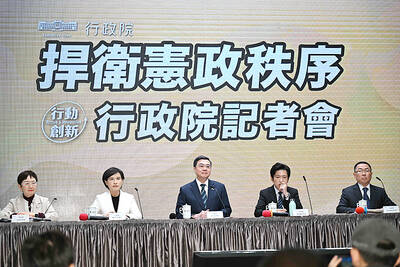Leaders of 16 nations from India to New Zealand inaugurated a new forum yesterday in ambitious efforts to chart a pan-Asian community -- a distant goal given rivalries festering among powers such as China and Japan.
The first East Asia Summit was the culmination of three days of meetings among the region's leaders in Kuala Lumpur, hosted by the 10-member ASEAN.
"It was very historic," Philippine President Gloria Macapagal Arroyo told reporters after the three-and-a-half-hour summit, noting that the group represents half the world's population and a third of its trade and income.
"The combined political will can do much to address issues that are of great interest to the region," she said.
The 10 ASEAN leaders joined with counterparts from Japan, China, India, South Korea, Australia and New Zealand. Russia attended as an observer, but there was no decision on its aspirations to be a full member.
Australian Prime Minister John Howard suggested the group stick with the current lineup for now: "It's a very manageable number around the table. If you make things too big, you lose the value."
The leaders pledged to cooperate in fighting bird flu, discuss security issues and meet every year, as sought by India.
India also is pushing for strong European-style integration aiming for a regionwide free trade area. However, no concrete action was taken toward that end.
A summit statement said merely that the group "could play a significant role in community-building in the region," but stressed its efforts wouldn't conflict with WTO talks on global free trade, currently under way in Hong Kong.
The Malaysia host, Prime Minister Abdullah Ahmad Badawi, said the leaders agreed that an "East Asia Community will be a reality in future as cooperation becomes stronger."
Japanese Prime Minister Junichiro Koizumi told other leaders that the East Asia Summit in coming years should "evolve into an opportunity for tackling concrete issues, not for just talk."
China and South Korea declined to hold one-on-one meetings with Japan during the summit. Both countries feel that Japan has not fully atoned for its brutal World War II past.
Indonesian Foreign Ministry spokesman Marty Natalegawa said continued tensions between Japan and China "would be inconsistent with the launching of an East Asian Community."
"Our hope has been that the two countries can find a way out of this situation," he said.
ASEAN comprises Brunei, Cambodia, Indonesia, Laos, Malaysia, Myanmar, Philippines, Singapore, Thailand and Vietnam.
Malaysia originally proposed the East Asia Summit as ASEAN plus Japan, China and South Korea, aiming to reduce US influence in the region.
But it took off only after the grouping evolved to include US allies Australia and New Zealand, with tacit approval of Washington, where officials have said they'll wait to see how the bloc's goals emerge before taking a firm stance on it.

The US government has signed defense cooperation agreements with Japan and the Philippines to boost the deterrence capabilities of countries in the first island chain, a report by the National Security Bureau (NSB) showed. The main countries on the first island chain include the two nations and Taiwan. The bureau is to present the report at a meeting of the legislature’s Foreign Affairs and National Defense Committee tomorrow. The US military has deployed Typhon missile systems to Japan’s Yamaguchi Prefecture and Zambales province in the Philippines during their joint military exercises. It has also installed NMESIS anti-ship systems in Japan’s Okinawa

‘WIN-WIN’: The Philippines, and central and eastern European countries are important potential drone cooperation partners, Minister of Foreign Affairs Lin Chia-lung said Minister of Foreign Affairs Lin Chia-lung (林佳龍) in an interview published yesterday confirmed that there are joint ventures between Taiwan and Poland in the drone industry. Lin made the remark in an exclusive interview with the Chinese-language Liberty Times (the Taipei Times’ sister paper). The government-backed Taiwan Excellence Drone International Business Opportunities Alliance and the Polish Chamber of Unmanned Systems on Wednesday last week signed a memorandum of understanding in Poland to develop a “non-China” supply chain for drones and work together on key technologies. Asked if Taiwan prioritized Poland among central and eastern European countries in drone collaboration, Lin

NO CONFIDENCE MOTION? The premier said that being toppled by the legislature for defending the Constitution would be a democratic badge of honor for him Premier Cho Jung-tai (卓榮泰) yesterday announced that the Cabinet would not countersign the amendments to the local revenue-sharing law passed by the Legislative Yuan last month. Cho said the decision not to countersign the amendments to the Act Governing the Allocation of Government Revenues and Expenditures (財政收支劃分法) was made in accordance with the Constitution. “The decision aims to safeguard our Constitution,” he said. The Constitution stipulates the president shall, in accordance with law, promulgate laws and issue mandates with the countersignature of the head of the Executive Yuan, or with the countersignatures of both the head of the Executive Yuan and ministers or

CABINET APPROVAL: People seeking assisted reproduction must be assessed to determine whether they would be adequate parents, the planned changes say Proposed amendments to the Assisted Reproduction Act (人工生殖法) advanced yesterday by the Executive Yuan would grant married lesbian couples and single women access to legal assisted reproductive services. The proposed revisions are “based on the fundamental principle of respecting women’s reproductive autonomy,” Cabinet spokesperson Michelle Lee (李慧芝) quoted Vice Premier Cheng Li-chiun (鄭麗君), who presided over a Cabinet meeting earlier yesterday, as saying at the briefing. The draft amendment would be submitted to the legislature for review. The Ministry of Health and Welfare, which proposed the amendments, said that experts on children’s rights, gender equality, law and medicine attended cross-disciplinary meetings, adding that